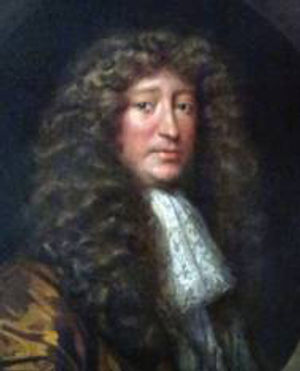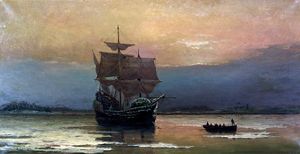Shropshire lad who went on to become one of America's founding fathers
The story of the More children is tragic, but it is also a cornerstone of the creation of the modern USA, and is being celebrated this year.

History records Richard More as one of the ‘Pilgrim Fathers’, but today you would probably call it people trafficking.
The eldest of the More children was eight years old, the youngest just four.
But when their father, the wealthy Shropshire landowner Samuel More, suspected his wife of an extramarital affair, he paid his employer to pack them off to the other side of the world.
The ship on which they sailed was to be The Mayflower. It is 400 years this summer since the famous vessel set sail from Plymouth for the brave New World, and about 1.4 million Americans are expected to head for Britain this year to learn about their ancestors’ roles in the foundation of modern America.
Richard was the only one of the four More children to safely make it to America, in what would have been truly horrendous conditions.
Shropshire’s Mayflower Children group has lined up a series of events over the summer to tell their story.

It might never have come to light had genealogist Sir Anthony Wagner not persuaded his friend Jasper More, later the MP for Ludlow, to dig around in his attic in 1959. It was then that Mr More found some old documents laying bare the awful truth about his ancestors.
Despite a flurry of initial interest, the story largely went quiet until it was taken up by Shropshire historian and former Shrewsbury schoolteacher Donald Harris in the late 1990s. Mike Brogden, secretary of Shropshire’s Mayflower Children group, remembers hosting a talk by Mr Harris in 1997.
“He packed out Shipton Hall, there were probably 100 people squeezed in there,” he says.
Impressed, Mr Brogden asked Mr Francis to produce a small booklet to make people more aware of the story.
The tale began with the unlikely marriage between 17-year-old Samuel More to his cousin Katharine at St James’s Church in Shipton in 1611.

Samuel’s father, Richard, owned the 1,000-acre Linley estate, near Norbury, while Katharine’s father Jasper owned the Larden estate at Shipton. While Jasper had sired three sons, they all died young, the last of them in an ill-judged duel over a lover.
Having no heir to the family seat, Jasper was keen to settle Katharine with her cousin so that the two estates would be combined. Significantly, the combined estates would pass down the family line.
It would not be a happy union. Katharine was accused of adultery with yeoman farmer Jacob Blakeway, who was one of Samuel’s tenants. By the time Katharine gave birth to her fourth child, Mary, in 1616, Samuel had decided that none of their children were his, noting that they looked too much like Blakeway for his comfort. In April that year the couple separated.
Katharine may have moved to London, while Blakeway fled after Samuel sued him for adultery. Samuel also successfully gained control of the children.
At the time Samuel was working as secretary to Lord Zouche, who was a member of the Virginia Company which had been transporting children to meet the need for labour in America.

Zouche, who had previously discarded a wife who displeased him, was probably sympathetic to his employee’s troubles, and his work made him well placed to “provide for the education and maintenance of these children in a place remote from those partes where these great blotts and blemishes may fall upon them”.
Meanwhile, a small group of Puritans were also seeking a move across the Atlantic to flee religious persecution, and this presented an attractive business opportunity for the Virginia Company.
For a fee of £10 per person, the Puritans were offered travel on the ship, free land in America, and unaccompanied children would be looked after by the adults. Samuel paid his boss £100 for his four children to be transported to America, with the Pilgrim leaders agreeing to care for the children and keep them with “meate drinke apparell lodginge”. After seven years they were to be given 50 acres of land each in Virginia.

After several delays, the Mayflower set sail from Plymouth on September 6, 1620. The ship had 102 passengers on board, and 30 crew members, and the conditions were appalling. The Mayflower should have been joined on the voyage by a second ship, The Speedwell, but this had been declared unseaworthy before the start of the expedition, so the overcrowded Mayflower made the trip alone.
By the time it left Plymouth, weather conditions had deteriorated. As the journey dragged on, food supplies dwindled. There was an outbreak of scurvy among the passengers, and the lack of safe drinking water meant they overindulged on beer.
The inclement conditions forced the ship to land at what is now Cape Cod in Massachusetts on November 11 – far from Virginia where they were meant to be going.
Hopelessly unprepared for the bitterly cold winter conditions, the crew and passengers stayed aboard the ship until March, by which time they had built huts in which to live. By that time, a contagious disease combining the symptoms of scurvy, pneumonia and tuberculosis had swept through the travellers. Only 53 passengers and half the crew survived.

Richard, the only survivor of the More children, made his home in what would become New Plymouth. He remained with the Brewster family who cared for him until 1627, and the following year was known to be working for Pilgrim Isaac Allerton, who was engaged in transatlantic trading.
According to Donald Harris’s research, More married Christian Hunter, a recent immigrant from England, in 1636. Shortly after, they moved to Salem, and at the age of 24 More had established himself as a successful sea captain, owning his own ship.
“He traded with Virginia and the West Indies, and probably made voyages to England, although there is no record of his seeking contact with the Mores,” he wrote.
“He served with his ship in 1653 in an unsuccessful expedition against the Dutch settlement on the Hudson, later to become New York. In the following year he took part in a successful operation against the French in what was to become Nova Scotia. Thus Richard More contributed to the foundations of New England’s maritime greatness.”
The couple had five sons and two daughters, but Christian died in 1677 and Richard married Jane Crumpton who had been widowed in a war with Indian tribes.
Jane died in Salem in 1686, and Richard continued to live there until his death about 10 years later. His later years were marred by scandal – in his 70s he was “convicted before justices of peace by three witnesses of gross unchastity with another man’s wife”. He was later to repent and was forgiven by the Church in 1691.
That may not have been his only skeleton in the cupboard, though, with suggestions he may have been up to no good during one of his voyages back to England. The parish register of St Dunstan’s Church in Stepney shows that in 1645, a mariner by the name of Richard More from Salem married Elizabeth Woolno of Limehouse.
He took his secrets to the grave – but was lucky to have one, being the only survivor of the Mayflower to have his own headstone at the Chester Street burial ground in Salem. He was also the longest-lived male survivor of the voyage.
The precise date of his death is uncertain, but records show it must have been some time between March 1694 and March 1696.
Mr Brogden, a retired headmaster, says the church visitor book shows a steady flow of American guests, presumably coming to see the building where the Mores were married and where their children were baptised.
“So many people in America claim that they are descended from the Mayflower passengers,” he says. “This sort of heritage seems to be a very big industry in America. If some of those found their way to Shropshire, that would be great.”
One site they will not be able to visit, though, is the More family’s house, Larden Hall. Sadly, it was demolished in 1969.





